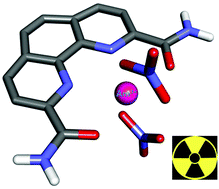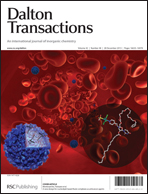2,9-Dicarbonyl-1,10-phenanthroline derivatives with an unprecedented Am(iii)/Eu(iii) selectivity under highly acidic conditions†
Abstract
Four lipophilic 1,10-phenanthroline di(thio)amide, diester or diketone derivatives were studied as ligands for Am(III)/Eu(III) separation from acidic media. The synthesis of these compounds is reported together with the extraction tests in different solvents (kerosene, octanol and o-nitrophenyl hexyl ether), HNO3 concentrations and ratios between the ligand and the synergistic agent (Br–Cosan). The promising results obtained from the large number of solvent extraction tests carried out show that it might be possible to apply this class of ligands to advanced reprocessing of spent nuclear fuel. The experimental data indicate that, under the conditions that simulate the real radioactive waste, the extraction efficiency and Am/Eu separation factors are particularly high, thus suggesting that the combination of soft heterocyclic N-donor atoms and hard carbonyl groups of ester and amides affords a tetradentate donor set of atoms (ONNO) that gives rise to remarkable selectivities. ESI-MS studies and DFT calculations shed light on the possible structure of the Eu3+ complexes indicating that the 1 : 1 : 2 (cation : ligand : anion) complex is slightly more stable than the 1 : 2 : 1 species.


 Please wait while we load your content...
Please wait while we load your content...